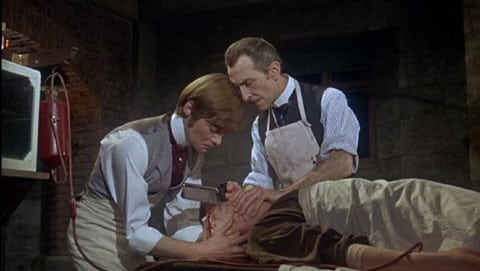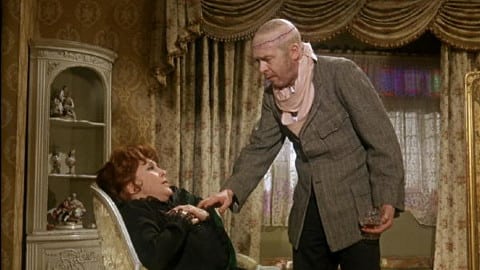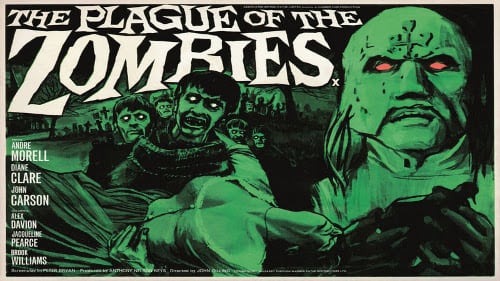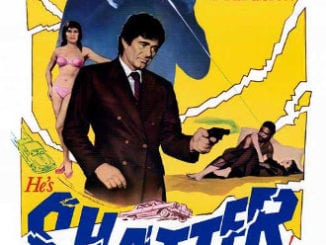Frankenstein Must Be Destroyed (1969)
Directed by: Terence Fisher
Written by: Anthony Nelson Keys, Bert Batt
Starring: Freddie Jones, Peter Cushing, Simon Ward, Veronica Carlson
UK
AVAILABLE ON DVD
RUNNING TIME: 101 mins
REVIEWED BY: Dr Lenera, Official HCF Critic
Baron Victor Frankenstein obtains a brain for his next experiment, but he’s surprised by a thief when he returns to his lab and a fight ensures. The Baron destroys most of the evidence and moves on, obtaining a room at a boarding house run by Anna, whose fiance Karl is a doctor at the local insane asylum where Dr. Brandt, a former scientific collaborator of the Baron’s, who has lost his mind, now resides. After discovering that Anna’s fiancee has been stealing narcotics in order to support her ailing mother, Frankenstein blackmails them into helping him kidnap the now insane Dr. Brandt so he can operate on his brain and cure him, thereby allowing the Baron to obtain his knowledge of brain transplantation….
Though I think I personally prefer Frankenstein Created Woman, I’m even more convinced than ever that Frankenstein Must Be Destroyed is the best of the Hammer Frankenstein pictures after watching it again last night, and a film which belongs in the studio’s top ten despite being curiously cheaper looking than the usual Hammmer product.. It’s directed by Terence Fisher with much of the pace [despite being Hammer’s longest horror film it doesn’t feel like it] and flair that he helped bring to The Devil Rides Out, and contains some tremendous set pieces. And it has a rather thoughtful, yet also incident-packed screenplay which makes it a great shame that Bert Batt, a man described by no less than John Huston as: “One of the two greatest first assistant directors in the world”, only wrote the script to this film and nothing else. Perhaps the reason that it isn’t as beloved by old-school horror fans as it maybe should be is that it concentrates on Frankenstein so much that the Monster is relegated to the result of a brain transplant, and is very much minimalised so that Frankenstein is the real Monster, and a total and utter bastard he is in this film too. It’s also a very nihilistic work, with most of the principal characters including the young hero and heroine dead by the end. Good hardly triumphs over evil here: the Frankenstein films were generally less cut and dry, and this one ends in a kind of stalemate with both sides virtually wiped out. The film pushes many of the themes in this franchise about as far as they can go, which is why the last two episodes seem so redundant. But I’m getting ahead of myself.
Anthony Hinds begun writing this in 1967 immediately after Frankenstein Created Woman, but was then sidetracked by producing duties on Hammer’s American-backed TV series Journey To The Unknown TV series. Batt and producer Anthony Nelson Keys then wrote a totally new treatment ignoring all of Hinds’s material, which Batt then turned into a screenplay, though he later added the characters of Inspector Frisch and Geoffrey Balydon during shooting. Shot at Elstree and at Stanmore Hall [Frankenstein’s hiding place towards the end] and the surrounding countryside [and doesn’t it almost seem wrong not to have Black Park in there somewhere?], production was delayed by snowfall causing continuity errors and requiring some re-shoots, causing the film to go over budget. When shooting was supposedly completed, Hammer studio head James Carreras, possibly being leaned on by the US co-producers and distributors Warner Bros and Seven-Arts, thought that the film needed more sex, so what did he do? – he ordered a rape scene be added where Frankenstein assaults Anna, which Fisher, Peter Cushing and co-star Veronica Carlson shot with great reluctance, Fisher storming off the set as soon as the last shot was done. Rather amusingly, the scene wasn’t included in the US release anyway, though it remained in the UK one, the BBFC only requiring the shortening of a couple of shots and sound effects from the brain transplant sequence. Frankenstein Must Be Destroyed was only moderately successful at the box office, proof that for the most part Hammer’s Dracula films tended to be more popular than their Frankensteins.
The opening seven or eight minutes might be the best of any Hammer film. A man plays a Third Man-style zither piece on a street while somebody, his face not shown, swings a sickle at another man about to go into his house, blood spattering all over the wall. The killer returns to his house and surprises a burglar who’s already regretted breaking into Frankenstein’s laboratory, being startled by a body standing up in a container. James Bernard’s typically expert scoring increases the effect of the cutting between burglar and You Know Who, the tension building well until a monstrous figure attacks the burglar, resulting in a fairly athletic fight which wrecks half the laboratory until the burglar flees and the monster mask is ripped off, revealing the face of Frankenstein, and telling you that he’ll be the real monster in this story. It doesn’t take long for him to relocate to a boarding house and blackmail the owner and her fiancée to assist him in his activities. The kidnapping of Brandt from the asylum is full of suspense, though it’s topped later on when the police are searching the boarding house, Fisher, aided of course by Bernard, ensuring that things reach almost Hitchcockian levels – and the Master of Suspense would have loved both the horror and the very dark humour of a burst water pipe unearthing a body recently buried in the garden by Frankenstein!
I have mixed feelings about the rape, which is quite brief, shot in close-up, and horrifying more because the dignified Cushing is the perpetrator. It does feel rather plonked in there and afterwards the characters react as if it didn’t happen, while Frankenstein hasn’t even been interested in the opposite sex since 1957’s The Curse Of Frankenstein. On the other hand it does make him even more a figure of evil which adds to the character’s and the film’s power. A bit of humour is provided elsewhere by the impatient and unsympathetic, snuff-sniffing Inspector Frisch who’s on Frankenstein’s trail, perhaps Thorley Walters’s best Hammer role though the actor is clearly suffering from a bad cold throughout. But generally this is a downbeat, even cruel, affair. One feels so much for the character of Ella Brand: she’s beset throughout the film by events. When she recognises Frankenstein as the man who may very well have driven her husband mad and visits the boarding house where he’s just given him a new body, Frankenstein acts kind, lets her see him and she experiences a small amount of joy in his reactions to her questions, but as soon as she’s gone he prepares to leave with him. Unfortunately neither Frisch and Ella appear in the final reel which is disappointing, though this is just about made up for by the pace of the action and a finale which recalls Mary Shelley, the ‘Monster’ carrying his ‘creator’ into a flaming house in maybe the best handled of Hammer’s climactic conflagrations.
The gore level is actually fairly low – the transplant [Brandt’s brain is dying, so it has to be put another body before it can be cured] cutting away from much of the detail, though there’s a deliberately callous nature to some of the violence. Frankenstein stabbing Anna was a real shock back when I first saw the film – pretty Hammer heroines didn’t die. Perhaps the studio’s most moving moment is when Brandt, in the other man’s body, visits Ella and talks to her from behind a screen because he doesn’t want her to see him. When she eventually does, sentimentality is totally avoided and there’s no proper ‘reunion’– she can’t stand the sight of him and will be not talked round. This film exists in a harsh world a bit different from the usual Hammer cosiness. Blackmailer, murderer, rapist, you name it – Frankenstein’s a man who, perhaps through years of failure, has completely lost his humanity [he doesn’t even smile, he sneers –look at the moment when Simon kills and he knows he’s now got him totally in his power] and yet there are bits when this diabolical anti-hero is rather cool, such as when he reminds four ignorant fellow hotel guests of the value of progress: “Had man not been given to invention and experiment, then tonight sir, you would have eaten your dinner in a cave, you would have strewn the bones about the floor, and then wiped your fingers on a coat of animal skin – in fact your lapels do look somewhat greasy”. Cushing is given some great lines to deliver throughout and he’s always note perfect, helping to turn a villain who you hate but can’t help but rather admire into a complex, tortured individual who’s still convinced that all his actions are for the greater good.
This was the last Hammer that Bernard Robinson designed, and actually some of the exterior sets are less convincing than normal, while most of the film has a deliberately cold, gray look to it. Fisher seems totally in control, using his slow zoom in technique several times and even employing some slightly shaky handheld camerawork several times, unusually for a director like him. Carlson basically plays Maria from Dracula Has Risen From The Grave again, and after Cushing it’s Freddie Jones who’s most memorable, notably when he awakes and sees his new face in the mirror. Jones totally transmits the horror of the situation with no dialogue. Bernard’s score, largely based around one of those themes that musically say the film’s title, constantly ramps up the tension, often by relying on that simple two note progression that the Jaws theme largely consisted of, though there’s also some wonderfully pounding fight music. Overall, Frankenstein Must Be Destroyed isn’t that easy a film to really like due to its cruel nature, but it has a ferocity, an intelligence, even a relevance, that makes it perhaps one of the best Hammer films to be put forth as evidence against the accusation that the studio tended to make dated, amusing, careless schlock.
Rating: 

















Be the first to comment